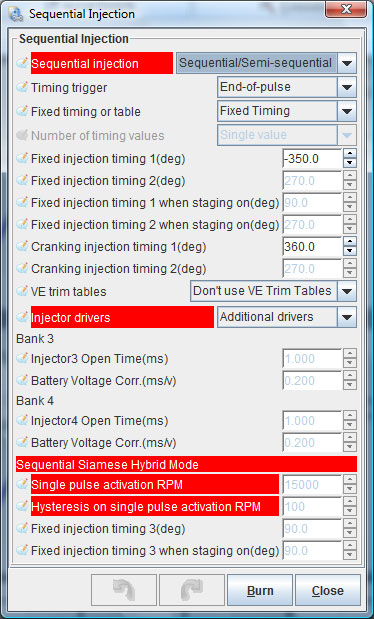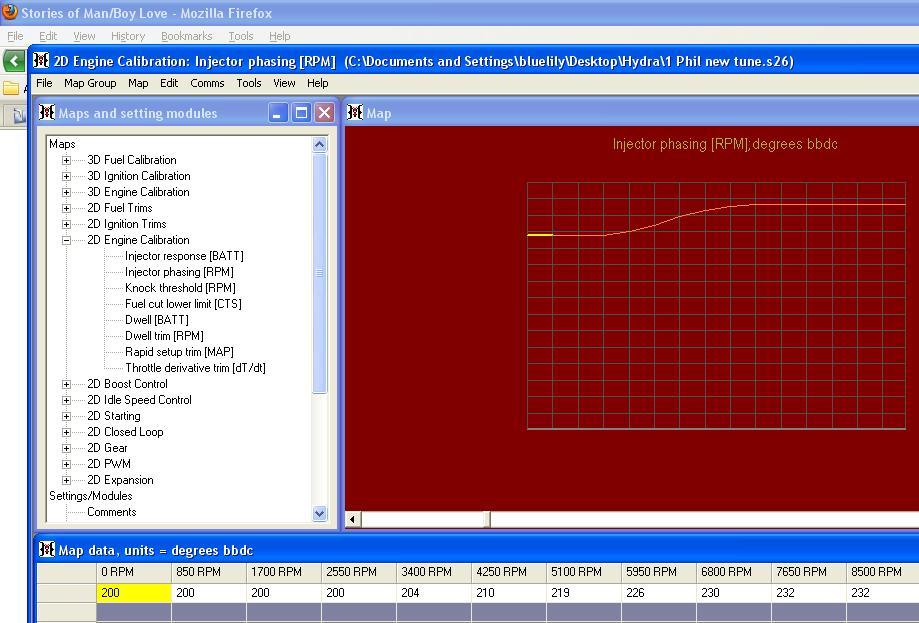Sequential Fuel injection
#1
Thread Starter
Junior Member
iTrader: (1)
Joined: Jul 2010
Posts: 74
Total Cats: 0
From: Seattle Area
What's the advantage of sequential injection versus the standard?
I did a search but didn't come up with much.
I'm planning on builing a MS and I'm not sure if I should go with the sequential add-on or not.
I could see how it could help gas mileage in theory, anyone out there who wen to sequential injection?
Any gains?
Gunter
I did a search but didn't come up with much.
I'm planning on builing a MS and I'm not sure if I should go with the sequential add-on or not.
I could see how it could help gas mileage in theory, anyone out there who wen to sequential injection?
Any gains?
Gunter
#7
My 2002 is all stock ignition and in looking through all the options inmy brand new MS from Reverent i noticed this screen:

I am very new to all the possible parameters that I can manually change but I'm pretty sure I need to turn that to Untimed correct ? My noob understanding tells me this is for when you have COPS ?? Or am I way off here ?

I am very new to all the possible parameters that I can manually change but I'm pretty sure I need to turn that to Untimed correct ? My noob understanding tells me this is for when you have COPS ?? Or am I way off here ?
#18
There are a few ways to do it, but I'll discuss what I know.
I use end-of-squirt timing, which means that the angle I enter represents the crank degree where is fuel is finished squirting.
There is a rule of thumb that says you want to aim for 5-10° before the intake valve open, so the fuel not only cools off the valve, its all there and gets pulled in when the valve opens and piston lowers.
so my cam opens my intake valve at 5°BTDC, so at idle I aim for -375° crank angle ( which comes out to 15° BTDC).
Now since the crank moves so much faster with increased RPMs and the injector can only open/close so fast, we try to inject the fuel a little earlier to factor in some latency and dead time. I think I inject 10° earlier every 500RPM. Something like that. Also doing the same as boost increases.
Then I tuned my fuel map until there were no more major changes. This is very important.
So now with your current fuel map, you need to pick an area where you'd like to experiment with; maybe retard the injection timing a little more and see if you need to add or subtract fuel. If you need to add, then it's not the ideal angle for that load/rpm. So then you need to go back to your original fuel map and try advancing that injection timing in that area instead.
When you start pulling fuel that injection angle is the ideal; basically you can achieve the same AFR with less fuel being injected because you found the most efficient angle to inject the fuel at that particular load/rpm area, less pooling and better atomization.
This will take a lot of time and patience, but in the end you should be able to achieve better MPG.
Also note, depending on the size of your injectors once you get to a certain DC% there's no real benefit, maybe around 75%, it'll pretty much be injecting the entire cycle that the intake valve is closed, so there's nothing you can do at that point.
I use end-of-squirt timing, which means that the angle I enter represents the crank degree where is fuel is finished squirting.
There is a rule of thumb that says you want to aim for 5-10° before the intake valve open, so the fuel not only cools off the valve, its all there and gets pulled in when the valve opens and piston lowers.
so my cam opens my intake valve at 5°BTDC, so at idle I aim for -375° crank angle ( which comes out to 15° BTDC).
Now since the crank moves so much faster with increased RPMs and the injector can only open/close so fast, we try to inject the fuel a little earlier to factor in some latency and dead time. I think I inject 10° earlier every 500RPM. Something like that. Also doing the same as boost increases.
Then I tuned my fuel map until there were no more major changes. This is very important.
So now with your current fuel map, you need to pick an area where you'd like to experiment with; maybe retard the injection timing a little more and see if you need to add or subtract fuel. If you need to add, then it's not the ideal angle for that load/rpm. So then you need to go back to your original fuel map and try advancing that injection timing in that area instead.
When you start pulling fuel that injection angle is the ideal; basically you can achieve the same AFR with less fuel being injected because you found the most efficient angle to inject the fuel at that particular load/rpm area, less pooling and better atomization.
This will take a lot of time and patience, but in the end you should be able to achieve better MPG.
Also note, depending on the size of your injectors once you get to a certain DC% there's no real benefit, maybe around 75%, it'll pretty much be injecting the entire cycle that the intake valve is closed, so there's nothing you can do at that point.















